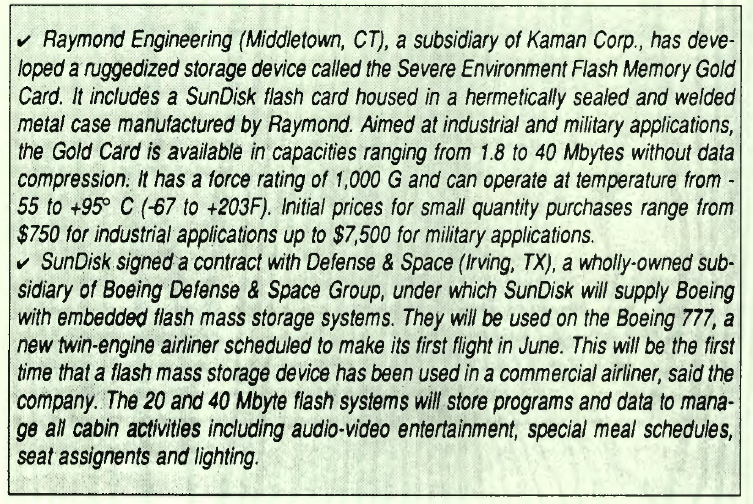History (1994): SunDisk Pioneer in Flash Card
Seagate first wanted to buy over entire company but finally had to settle with 25% equity position.
By Jean Jacques Maleval | December 30, 2020 at 2:41 pmSunDisk Corp. (Santa Clara, CA) designs, markets and manufactures solid-state mass storage products using proprietary flash memory technology.
The privately-owned company was founded in 1988 by Dr. Eli Harari, 48, a pioneer in non-volatile memory design and semiconductor specialist who holds more than a dozen US and foreign patents.
Its sales in 1993 are estimated at about $20 million, an amount that should double this year.
It employs 100 engineers, scientists, and sales/marketing professionals.
Manufacturing in Japan, Korea and Thailand
Based on its own design, the standard 4, 8 and recently 16Mb chip are manufactured in the Masushita Kyoshu foundry in Japan.
Both companies entered in a 5-year expandable partnership 4 years ago. These chips are then sent to a Korean subcontractor, Anam, that mounts them into modules. Final assembling of the flash cards is done in Thailand by GSS. All the production then goes to SunDisk in California where the cards are tested and from where all the shipments leave.
SunDisk plans to have a second foundry source as soon as 1995 with a new unidentified partner.
According to Leon Malmed, VP WW marketing and sales, SunDisk, his company currently ships 15,000 flash cards per month WW, in various capacities (1.8, 2.5, 5, 10 and 20MB). Based on 16Mb chips, the first 40MB units are just starting to be sold. Main sales concern 5MB cards that cost $350 to $360, end user price. Another 1.8MB card costs about $200, the 20MB one close to $1,000 or $50 per megabyte.
This is a native capacity here, it can be doubled with Stacker, the data compression software from Stac Electronics that SunDisk uses for its cards.
Last May was revealed the SDP5-1, a 1MB flash expected to carry an end-user price ranging only between $169 and $189 ($100 in OEM) to compete with SRAM. Next step will be 80MB cards based on 32Mb chip and using 3.3X, compared to 5V in current models.
Motorola is designing the customized 2 chip ICs for its new PCMCIA ATA card to be shipped in the second half of this year, with high volume production in early 1995.
SunDisk foresees a 100MB card within less than a decade using 64Mbb chips.
The chips are based on the NOR technology used by Intel and others where cells are accessed in parallel, while NAND serial access is developed by Toshiba and its licensees Samsung and National.
Backed by Seagate, SunDisk has raised over $27 million in venture capital. The company is backed by VCs including Concord Partners, US Venture Partners, Oak Ventures, the Mayfield Group, and Matrix Partners.
Among SunDisk’s shareholders, there are AT&T which owns 4 to 5% of the capital (its first 8Mb flash EEPROM chip was developed in partnership with AT&T Bell Laboratories), and mainly Seagate Technology (Scotts Valley, CA) who had first wanted to buy over the entire company but finally had to settle with a 25% equity position which lets SunDisk have a strong cash position, particularly when the company will go public and this could happen in about a year from now.
The agreement provides that Seagate will market and distribute the cards worldwide, except in Japan (where SunDisk has its own subsidiary, SunDisk K.K., in Yokohama), using both Seagate and SunDisk brand names, which has been the case for several months.
The Californian company also has worldwide agreements with Epson and Verbatim. But there is no exclusivity and SunDisk still markets its own products using its own brand name.
Among its large OEMs there are IBM, Hewlett-Packard, Tandy and AST Research.
“First of all: compatibility“
“Our strategy is first of all based on compatibility for flash cards to become the floppy disks of the’90s. We are working with all OEMs to assure this compatibility,” said Malmed, a former executive VP at SyOuest Technology.
This is why, ‘FlashDisks’, all using a 5V power supply, are designed to mimic the file structure of a disk drive using the same 512B sector size.
They are three large families. First, the IDE Series and the SDI Series, an embedded application, are designed with their integrated controllers to operate as plug-in play replacements for 2.5-inch and 1.8-inch IDE HDD drives respectively. The controller and the data management of the SDI and IDE Series are also used for the third family of products, the SOP Series which conforms to the PCMCIA-ATA standard. They can operate on portable computers like the HP95LX, NCR 3170, Fujitsu PoqetPad, Sharp PC-3000 and PC-6781.
Recently, the SOP Series was approved and certified by IBM’s Boca Raton Technical Services (BATS).
Competition
SunDisk’s main competitors are Intel, the market leader, the other large players being AMD, Toshiba, Hitachi, Fujitsu, NEC, Sharp and Excel-Rohm.
But the market is having a hard time taking off, following is Intel’s statement on its 1094 results: “Demand is increasing, but not at a rate we had planned. Flash memory unit shipments increased during the quarter with expanded factory capacity able to meet demand. Revenue grew vs. last year’s first quarter, but was essentially flat relative to 4Q93 due to declining prices and slow user acceptance of OEM customers’ personal digital assistant products featuring flash memory storage devices.“

This article is an abstract of news published on the former paper version of Computer Data Storage Newsletter on issue 77, published on June 1994.













 Subscribe to our free daily newsletter
Subscribe to our free daily newsletter

